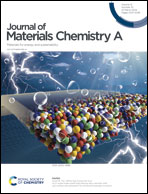Construction of Bi-based amorphous/crystalline heterostructures for efficient potassium ion storage†
Abstract
The volume expansion and slow kinetics resulting from the large radius of the potassium ion during cycling have led to significant challenges in the development of high-performance anode materials for potassium ion batteries (KIBs). In this study, a novel anode material for KIBs was prepared using the precipitation method, involving the in situ growth of amorphous 0D Bi2S3 nanoparticles on 2D Bi2O3 nanosheets. The design of a typical thin 2D structure facilitates close contact between the active material and electrolyte, effectively shortening the K+ transport length. Additionally, the inclusion of amorphous Bi2S3 not only creates a built-in electric field, reducing the activation energy and speeding up charge transport, but also offers extra K+ storage sites to enhance K+ diffusion kinetics. Theoretical calculations show that the K+ adsorption energy is enhanced and the diffusion of K+ is promoted due to the formation of an amorphous/crystalline heterostructure. Consequently, this carbon-free composite delivers impressive reversible specific capacities of 226 mA h g−1 at 1000 mA g−1 as an anode material for KIBs. Our study provides a new pathway for synergistically regulating the crystallinity and two-phase heterogeneous interface of anodes for high performance KIBs.



 Please wait while we load your content...
Please wait while we load your content...